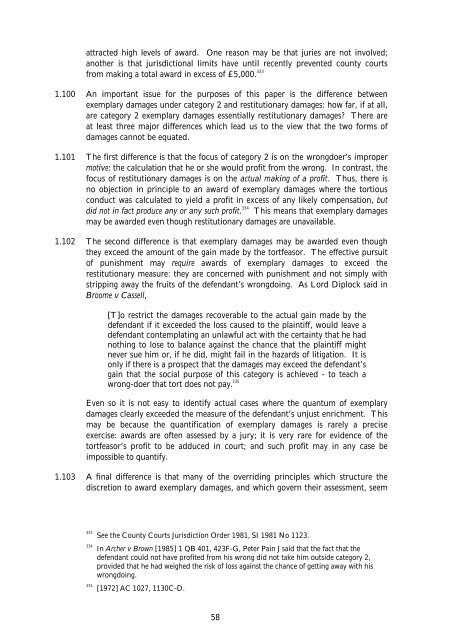Aggravated, Exemplary and Restitutionary ... - Law Commission
Aggravated, Exemplary and Restitutionary ... - Law Commission
Aggravated, Exemplary and Restitutionary ... - Law Commission
You also want an ePaper? Increase the reach of your titles
YUMPU automatically turns print PDFs into web optimized ePapers that Google loves.
attracted high levels of award. One reason may be that juries are not involved;<br />
another is that jurisdictional limits have until recently prevented county courts<br />
from making a total award in excess of £5,000. 333<br />
1.100 An important issue for the purposes of this paper is the difference between<br />
exemplary damages under category 2 <strong>and</strong> restitutionary damages: how far, if at all,<br />
are category 2 exemplary damages essentially restitutionary damages? There are<br />
at least three major differences which lead us to the view that the two forms of<br />
damages cannot be equated.<br />
1.101 The first difference is that the focus of category 2 is on the wrongdoer’s improper<br />
motive: the calculation that he or she would profit from the wrong. In contrast, the<br />
focus of restitutionary damages is on the actual making of a profit. Thus, there is<br />
no objection in principle to an award of exemplary damages where the tortious<br />
conduct was calculated to yield a profit in excess of any likely compensation, but<br />
did not in fact produce any or any such profit. 334<br />
This means that exemplary damages<br />
may be awarded even though restitutionary damages are unavailable.<br />
1.102 The second difference is that exemplary damages may be awarded even though<br />
they exceed the amount of the gain made by the tortfeasor. The effective pursuit<br />
of punishment may require awards of exemplary damages to exceed the<br />
restitutionary measure: they are concerned with punishment <strong>and</strong> not simply with<br />
stripping away the fruits of the defendant’s wrongdoing. As Lord Diplock said in<br />
Broome v Cassell,<br />
[T]o restrict the damages recoverable to the actual gain made by the<br />
defendant if it exceeded the loss caused to the plaintiff, would leave a<br />
defendant contemplating an unlawful act with the certainty that he had<br />
nothing to lose to balance against the chance that the plaintiff might<br />
never sue him or, if he did, might fail in the hazards of litigation. It is<br />
only if there is a prospect that the damages may exceed the defendant’s<br />
gain that the social purpose of this category is achieved - to teach a<br />
wrong-doer that tort does not pay. 335<br />
Even so it is not easy to identify actual cases where the quantum of exemplary<br />
damages clearly exceeded the measure of the defendant’s unjust enrichment. This<br />
may be because the quantification of exemplary damages is rarely a precise<br />
exercise: awards are often assessed by a jury; it is very rare for evidence of the<br />
tortfeasor’s profit to be adduced in court; <strong>and</strong> such profit may in any case be<br />
impossible to quantify.<br />
1.103 A final difference is that many of the overriding principles which structure the<br />
discretion to award exemplary damages, <strong>and</strong> which govern their assessment, seem<br />
333 See the County Courts Jurisdiction Order 1981, SI 1981 No 1123.<br />
334 In Archer v Brown [1985] 1 QB 401, 423F-G, Peter Pain J said that the fact that the<br />
defendant could not have profited from his wrong did not take him outside category 2,<br />
provided that he had weighed the risk of loss against the chance of getting away with his<br />
wrongdoing.<br />
335 [1972] AC 1027, 1130C-D.<br />
58
















